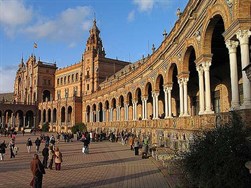Seville
 First conquered by the Visigoths (fifth century) and then the Muslims (eighth century), Seville became part of the kingdom of Castile and León in 1248, holding, in later centuries, a prominent role within the Spanish monarchy. In 1481 the first auto de fe of the Spanish Inquisition was held in Seville, but the history of the city changed especially with the discovery of the Americas (1492). Seville became the centre of commerce and communications with the New World (through the Casa de Contratación and the Universidad de Mercaderes), thus becoming cosmopolitan and populous: during the sixteenth century it surpassed 100,000 inhabitants. A large part of the local heritage is of the same period. Undergoing a crisis, along with the kingdom of Castile, in the seventeenth century, Seville was decimated by the plague outbreak in 1649, during which almost half of the population died. From the cultural point of view, however, Counter-Reformation and Baroque Seville was full of churches and convents which flourished thanks to the skill of artists such as Valdés Leal, Zurbarán, Murillo, Martínez Montañés and Juan de Mesa. In 1717 the Casa de Contratación was moved to Cadiz, with consequent economic and political damage to Seville. The Lisbon earthquake of 1755 caused deaths and serious damage to the city’s artistic heritage. (photo: Plaza de España, Seville)
First conquered by the Visigoths (fifth century) and then the Muslims (eighth century), Seville became part of the kingdom of Castile and León in 1248, holding, in later centuries, a prominent role within the Spanish monarchy. In 1481 the first auto de fe of the Spanish Inquisition was held in Seville, but the history of the city changed especially with the discovery of the Americas (1492). Seville became the centre of commerce and communications with the New World (through the Casa de Contratación and the Universidad de Mercaderes), thus becoming cosmopolitan and populous: during the sixteenth century it surpassed 100,000 inhabitants. A large part of the local heritage is of the same period. Undergoing a crisis, along with the kingdom of Castile, in the seventeenth century, Seville was decimated by the plague outbreak in 1649, during which almost half of the population died. From the cultural point of view, however, Counter-Reformation and Baroque Seville was full of churches and convents which flourished thanks to the skill of artists such as Valdés Leal, Zurbarán, Murillo, Martínez Montañés and Juan de Mesa. In 1717 the Casa de Contratación was moved to Cadiz, with consequent economic and political damage to Seville. The Lisbon earthquake of 1755 caused deaths and serious damage to the city’s artistic heritage. (photo: Plaza de España, Seville)
